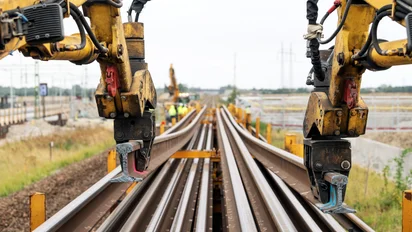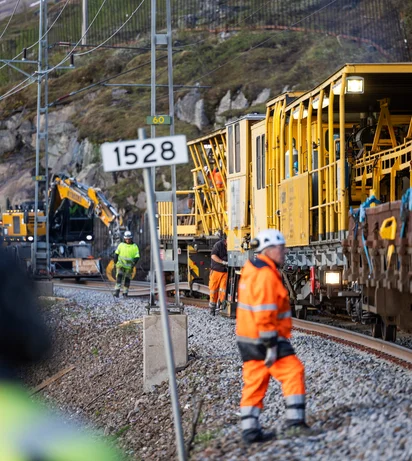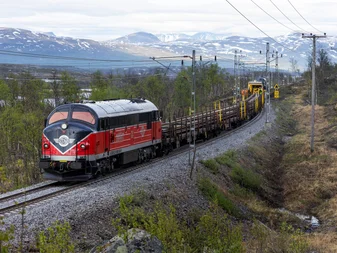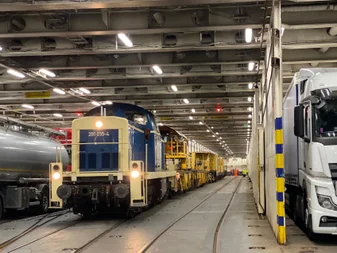Even with the best rail maintenance, there comes a time when the rails need to be replaced. Vossloh has a special solution for this major undertaking: the fastest rail replacement system. Thanks to the high working speed of up to 3,240 meters of track per shift, shutdown and construction times are reduced to a minimum.
Modular system: So simple, so good
This nearly 300-meter-long rail replacement system from Vossloh combines all work steps in a continuous flow process, as it is based on modular vehicles that are assembled on a project-specific basis depending on the rail transport system (Robel, STS, or public wagons).
The vehicle combination always starts with a work train locomotive and long rail transport unit for the delivery and removal of new and old long rails, followed by the corresponding loading and unloading modules and the exchange module.
In combination with the mobile welding unit for flash butt welding (RA welding) and a hydraulic pulling device for stress equalization, the result is a seamless track of maximum quality and at an unparalleled speed of up to 600 m of track per hour.
References
Customers primarily plan rail replacement projects on a cycle basis with a longer lead time, so that the route can be analyzed in advance to ensure smooth shift operation. Potential sticking points that could interrupt rapid progress are identified and taken into account when planning shifts and packing the rail strips. Vossloh's rail replacement teams have been working on a rotating basis on the HSL Zuid between Amsterdam, Rotterdam, and Antwerp since 2017.
However, sometimes there are ad hoc requests, such as the one from Sweden. At the end of February 2024, shortly after the reopening of the economically important Malmbanan railway, another heavy freight train carrying ore derailed. The rail replacement method was used to replace the damaged rails on a 15 km section and restore the single-track ore railway line in northern Sweden to working order. As it is not licensed in Sweden, the rail replacement train ultimately operated with a special work permit for one year and a special operating permit.
In addition, the deflectors had to be adapted to the rail fastening system (clips for the first time). And last but not least, after swift but meticulous preparation, the work direction was changed one day before departure. As a result, the rail tracks and construction schedules had to be changed at short notice.
For this project, the rails were delivered on public wagons with 36 rails, each measuring 120 m. This resulted in a configuration for the rail replacement wagon with a transfer device consisting of a loading and unloading wagon (AAW), the K wagon, and the SWW replacement module.
Rail replacement in record time
The busy high-speed line between Cologne and Frankfurt was completely closed for four weeks for renovation work. In order to complete the necessary work (track renewal over 53 km) on schedule, the work steps were separated and the faster replacement train did not wait for the welding truck as is usually the case. Additionally, precisely cut rail fittings were not used. This meant that every seventh pair of rails had to be laid overlapping so that this excess material could be used to close the gap created during the welding process. At the end of a construction phase, the last pair of rails was also laid overlapping the old track. Another special feature was the installation of milled 40-meter-long rails. With a height of 166 mm and 169 mm, they served as ramps in front of and behind the turnouts remaining on the track to compensate for the difference in height between the new rails (172 mm) and the old rails.
During the night, the rails were replaced with STS transport units, sequentially welded, and neutralized. The following day, the old rails were removed using the SLW and Robel-TE. This alternative option is the self-propelled crane portal wagon, which runs on rails laid along the entire length of the Robel transport unit. Using the hydraulic crane arms mounted on the portal wagon, together with a system of guide channels, guide rollers, and slides, the SLW enables the installation and removal of long rails up to 360 meters with a speed of approximately 1,800 meters of track per hour – making it the fastest and most efficient solution for this task.
In this way, 106,200 m of rail were replaced and seamlessly welded in less than a month. Generally, 36 rails, each 120 m long, are delivered and laid per shift; for this project, the record was 66 rails, each 120 m long—meaning 7,920 m of rail (3,960 m of track) in one shift. Due to the steep gradients, up to four locomotives were needed to transport such a large number of rails to the track.







.jpg?format=webp&quality=85&crop=956.4,956,x372.1,y229.9&width=60)